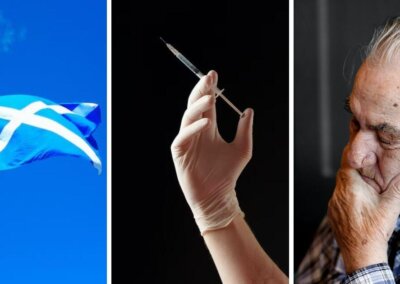A Government review has revealed that abortion complication rates are likely much higher than has been previously reported in the annual abortion statistics
Released earlier this week, the review compared two different means of analysing complications following an abortion. Over a five year period from 2017-2021, the Office for Health Improvement and Disparities (OHID) compared the complication rate derived from the annual abortion statistics which uses the Abortion Notification System (ANS) based on data provided by abortion providers, with the abortion complication rate from Hospital Episode Statistics (HES) over the same time period.
Over a five year period from 2017-2021, the review found the average abortion complication rate was 1.52 per 1,000 abortions using data derived from the ANS as used in the annual abortion statistics. However, the review also found the average abortion complication rate over the same time period using data from HES was 4.06 , over 2.6 times higher. When the HES data analysis also includes incomplete abortions, the complication rate over the same period is 18.16 per 1,000 abortions. This is over 11.9 times higher than the ANS-derived complication rate used in the annual abortion statistics which does not include incomplete abortions.
The review also found that the difference in reported complications rate is much higher for women under 20 than for the general population. For women under 20, the HES-derived complication rate is 4.43 times higher than the ANS-derived complication rate , compared to 2.67 times higher for the general population. When the HES data analysis also includes incomplete abortion, for under 20s the HES-derived complication rate is 17.43 times higher than the ANS-derived complication rate , compared to 11.95 times for the general population.
Abortion complication rate for medical abortion increases with gestational age
ANS-derived complication rates by gestation show that the complication rate for medical abortions taking place between 10 to 12 weeks compared to 2 to 9 weeks is 18.33 times higher. This complication rate increased to 110 times higher for abortions at 13 to 19 weeks and 160.33 times higher for abortions at 20 weeks and over when compared to medical abortions that occurred at 2 to 9 weeks.
The data from 10 weeks or more is for medical abortions that took place in a clinical setting, since medical abortion outside of this setting is not legal after 10 weeks. The complication rate for women who perform their own medical abortion outside of a clinical setting at 10 weeks or beyond is likely to be much higher than the rates when women are receiving in-person medical supervision.
According to the review, the most common abortion complications reported in the ANS data for 2021 were haemorrhage (65.8%), sepsis (11.4%) and cervical tear (11.1%) and for the HES data, delayed or excessive haemorrhage (81.4%), Other and unspecified (10.6%), genital tract and pelvic infection (8.0%) and embolism.
Gaps in abortion complication data
The review also identified that abortion providers were not recording complications that happened after discharge or after the form that they were recorded on was sent to the Department of Health and Social Care (DHSC). Abortion providers are required to submit a HSA4 form which contains any complications that occurred as a result of an abortion but only up to the point of discharge. However, when the review was undertaken in 2022, the OHID noted that there was “no evidence” that abortion providers were informing the DHSC to ensure the data was updated when a woman informed the abortion provider about a complication that occurred after the form had been sent.
‘DIY’ home abortions
The review also noted that complications may be less likely to be recorded for terminations where either both or one of the abortion medications is administered at home, because it is unlikely that the person filling in the HSA4 form will know if the woman experienced a complication following an abortion.
This underreporting is a likely explanation for why there was a reduction in ANS-reported complication rates in 2020, the same year that at-home abortion was introduced. This reduction in reported complication rates was referred to by Diana Johnson MP in a speech to Parliament when MPs were deciding on whether to make at-home abortion available permanently. She said that complications from abortion had reduced since the introduction of at-home abortion, without letting Parliament know that this was likely due to underreporting.
In fact, the HES-derived data shows the highest complication rate for the 5 year period occurring in 2021, the year after at-home abortions were introduced. The complication rate for 2021 is 4.4 per 1,000 abortions excluding incomplete abortions and 19.3 per 1,000 including incomplete abortions.
Right To Life UK spokesperson Catherine Robinson said: “This Government’s review reveals that abortion complication rates are likely much higher than has been previously reported in the annual abortion statistics, which are based on reporting from abortion providers”.
“We are calling on the Government to urgently introduce new measures to ensure that abortion complications data is accurately collected and reliably reported on”.
“ANS-derived complication rates by gestation show that the complication rate is 160 times higher for abortions at 20 weeks and over when compared to medical abortions that occurred at 2 to 9 weeks. The data from 10 weeks or more is for medical abortions that took place in a clinical setting, since medical abortion outside of this setting is not legal after 10 weeks. The complication rate for women who perform their own medical abortion outside of a clinical setting at 10 weeks or beyond is likely to be much higher than the rates when women are receiving in-person medical supervision”.
“This reinforces the urgent need for the Government to heed calls to reinstate in-person appointments before all abortions take place to ensure that the gestation of babies can accurately be assessed, given that the abortion provider, the British Pregnancy Advisory Service sent out abortion pills to a woman whose baby, Lily, was at least 32 weeks gestation, and given the fact that this does not appear to be an isolated case. It is likely that these cases would not have happened had the gestation of the babies been accurately identified by ultrasound or a physical examination during an in-person appointment”.












